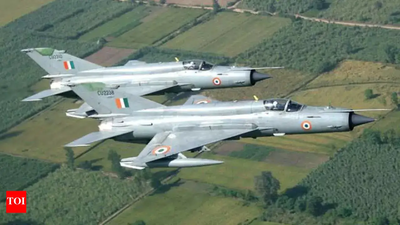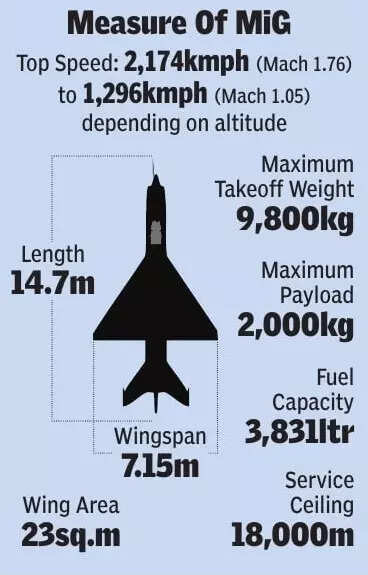ARTICLE AD BOX

In exactly a month, the MiG-21 will make its final touchdown in Chandigarh after six decades of service in IAF. The pilots who’ve flown it and known it inside out say this legend will forever stay in their heartsCHANDIGARH: Dec 1971. An Indian fighter pilot has just dropped two 500kg bombs on Pakistan’s Rafiqul air base and is peeling away for home when he realises there are four ‘bandits’ on his tail — US-made F-86 Sabres.“The odds weren’t good,” Air Marshal (retd) Prithvi Singh Brar chuckles. “I thought I was seconds away from death,” he says, sitting in his Chandigarh home. But then, his instincts kicked in, years and years of pushing himself and his warbird beyond the limit. He gunned his jet and tore through the sky, putting every sinew, nerve and blood vessel, and every rivet, bolt and plate past breaking point.Fighting incredible g-forces, man and machine became one.
“The Pak jets dropped out. They couldn’t keep up,” Brar says with pride undimmed by 54 years. His jet brought him home. That was the MiG-21.As the sun sets on MiG-21’s service in Indian Air Force (IAF), the voices of those who trusted their lives to its cockpit offer a heartfelt narrative — not of a machine that inspired misigivings, but one that is remembered with gratitude and pride. Brar, one of India’s seniormost pilots and former Vice-Chief of Air Staff, says the MiG-21 was not just a weapon of war but a buddy and a trusted companion — the proving ground for generations of fighter pilots.
“I love the MiG-21, it never let us down in operations,” says Brar. “When you fly an aircraft, you fly because you love it. It’s like a sport.” Now 86, he was one of the first pilots to be trained on the MiG-21. “We learned to explore its best. We became a group of people who knew how to make the most of it. It never let us down,” he says.The IAF veteran’s enduring bond with the MiG21 can be gauged from the fact that he first flew it over the skies of Chandigarh in 1966 and, for the last time, in 2000, just two days before his retirement.“The term ‘flying coffin’ was coined by the media — to convey the grief of a pilot’s mother or wife — while covering an unfortunate incident. It was never how we, the pilots, saw the aircraft,” he points out. As a young pilot in the 1971 Indo-Pak War, Brar flew his MiG-21 from Amritsar into Pakistan territory, trusting his life and mission to the delta wings.Brar remembers when Pakistan bought its first supersonic Americanmade Starfighter.
“The fact that our neighbour had supersonic aircraft was an explosive situation. India approached Russia, and the MiG-21 arrived in the early sixties.”He was part of the No.1 Squadron in Adampur that shaped the MiG-21 in accordance with the needs of the IAF and Indian conditions.“In July 1966, I, along with some selected pilots, was assigned to be trained on the MiG-21 at Chandigarh, where it was initially inducted with 28 Squadron in 1963,” he says.“We were trained by 45-Squadron, which went to Russia for the initial induction. It was a supersonic delta-wing aircraft, which used to land at speeds of 330kmph. After initial training, we were moved to No.1 Squadron in Adampur with brand new MiG-21 aircraft. In those days, flying suits also came from Russia. After the Russian training, the No.1 Squadron became the first to train itself to become operational per their needs and conditions,” he explains.The pilots learned bombing and rocketing at Adampur. MiG-21 was designed for high speed, high altitudes, and to shoot down enemy aircraft with missiles, he says. At Adampur, one of the pilots suffered an engine failure during a training sortie but the MiG-21 was so good that it still landed safely, he recalls. A Tactic and Combat Development Squadron was established in Adampur in 1970.In April 1971, when war clouds started gathering, they were told to intensify training.
“It was the first time a single engine, single-pilot aircraft was used for night flying. We used to conduct sorties from Hindon to Amritsar. For almost six months, we did a lot of flying exercises before going to war in Dec 1971,” he said. “It was because of our training and reliability and the speed of MiG-21 that we could bomb several airbases of Pakistan.
We surprised everybody with the MiG-21,” Brar adds.Brar also trained Iraqi pilots on the MiG-21 when he was deployed in Iraq on a special assignment.Asked about its phasing out, Brar says every aircraft is designed for a certain number of years, service, and hours. “An aircraft is made of certain material, which has a life. So, the aircraft was overdue for replacement. Jaguar should also be rejected now,” he says. As for the ‘flying coffin’ tag, nobody talks about its flying hours, he points out. “IAF’s accident rate has never been worse than that of the US and European air forces,” Brar adds.

The workhorseIntroduced in 1963, the MiG-21 — IAF’s first supersonic jet fighter that’s set to fly into the sunset on Sept 19 at Chandigarh airbase — combined speed, agility and lethal precision. Designed by the Soviet aircraft manufacturer Mikoyan-Gurevich, MiG-21 began production in 1959 and entered service the same year, going on to feature in the air forces of around 60 countries. In India, the jet was assembled by Hindustan Aeronautics Limited (HAL) with more than 1,200 MiG-21s having worn IAF roundels.The IAF operated several variants, including the MiG-21FL (Type 77), MiG-21M/MF (Type 96), and the MiG-21bis (Type 75). Over 100 MiG-21s were modernised to the ‘Bison’ standard with advanced avionics, multi-function displays, and an electronic warfare suite.The MiG-21 served in the 1965 and 1971 Indo-Pak wars and the 1999 Kargil War. During the 2019 border skirmish with Pakistan, Wing Commander Abhinandan’s MiG-21 Bison shot down a Pakistani F-16, a claim Pakistan disputes.Yet, alongside its victories, the jet also picked up monikers like the ‘Flying Coffin’ and ‘Widow Maker’ owing to a string of fatal accidents. Over 200 IAF pilots are reported to have lost their lives in crashes of different MiG variants.At its peak, the IAF operated 400 MiG-21s in 19 squadrons. Between 2017 and 2024, at least four MiG21 squadrons were phased out. Although originally scheduled for retirement by 2022, the phasing out was delayed due to the slow induction of indigenous Light Combat Aircraft (LCA) Tejas, which is set to replace the MiG-21 squadrons.



.png)
.png)
.png)
















 7 hours ago
3
7 hours ago
3







 English (US) ·
English (US) ·